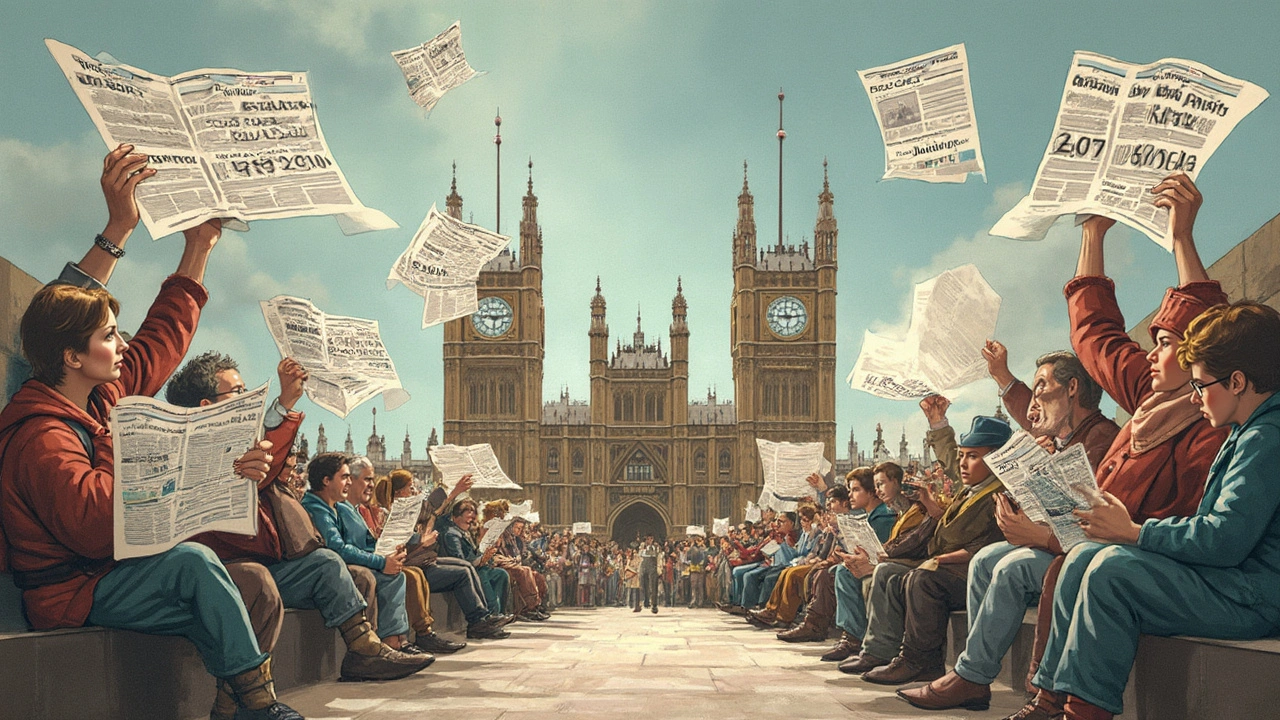
You don’t have to scroll far on social media before bumping into a heated debate about so-called “biased journalism.” And right in the thick of it stands The Guardian, one of Britain’s best-known newspapers. Some folks swear it’s a Labour mouthpiece, others roll their eyes and insist it’s merely progressive. But where does The Guardian really stand when it comes to British political parties? The answer isn’t as clean-cut as it first looks. Let’s take a proper look under the bonnet of The Guardian’s history, editorial line, and the ways it shapes—and reflects—our political landscape.
The Guardian's Roots: Radical Beginnings and Evolving Loyalties
Look back to the Manchester of 1821, just before Queen Victoria took the throne, and you’ll find the birth of The Guardian. This wasn’t a newspaper for toffs. It came about after the Peterloo Massacre, with a mission to campaign for civil liberties, workers' rights, and social reforms. It started out backing the Whigs, who became the Liberal Party, and spent much of its 19th and early 20th-century life waving the Liberal banner. The Manchester Guardian’s early editors pushed for free trade, parliamentary reform, and social improvement, mainly sticking up for the working and middle classes in the industrial north.
Fast forward to the mid-20th century, as the Liberals faded and the political left re-shaped, and you start to see a shift. After the Second World War, Labour replaced the Liberals as the main party of reform, and The Guardian naturally drifted left, echoing changes in its readership and the country at large. In 1959, it dropped “Manchester” from its name, going national with a steady focus on progressive change. If you crack open museum archive editorials from the 1960s onward, the support for Labour begins to shine through, though The Guardian held onto a reputation for independent scrutiny—even of Labour governments.
The paper’s style was never about toeing any party line. It got a reputation for being thoughtful, sometimes long-winded, but always rooted in arguments rather than party dogma. Even as its readers drifted leftwards, the editorial tone kept some room for liberal criticism and a little healthy scepticism about promises from any politician, red rosette or not.
Endorsements: The Guardian at Election Time
When there’s an election, most papers stick their colours to the mast. Britain’s press is more openly partisan than in the US. So, do The Guardian’s endorsements tell us where its loyalties lie? Here’s where things get interesting. Since the 1980s, The Guardian has repeatedly and openly endorsed Labour at general elections—but the story isn’t always straightforward.
During Tony Blair’s New Labour years, starting in 1997, the paper confidently backed the party, embracing its blend of social justice and economic competence. The Guardian stood especially firm in the 1997, 2001, and 2005 elections. Yet, cracks appeared. The 2003 Iraq War split the left, and The Guardian ran headlines and comment pieces fiercely criticising Blair’s government, calling the march to war a betrayal of the paper’s values. Some readers accused it of sitting on the fence—with too many opinion columns weighing the pros and cons of Labour’s transformation.
Jump to 2010. The Guardian shocked some of its loyal readers when it endorsed the Liberal Democrats for the first time in ages, backing Nick Clegg amid the expenses scandal and Brown’s stumbling Labour leadership. That episode shows that, while The Guardian has a Labour-leaning tradition, it’s not always a given. But, in 2015, 2017, and 2019, the paper went back to supporting Labour, making the case for an alternative to austerity, Brexit, and the rise of Boris Johnson’s Conservatives.
An endorsement isn’t everything. Plenty of Guardian columnists challenged Labour leadership—Owen Jones writing blistering takes against his own party’s direction, or Polly Toynbee calling for urgent modernisation. Readers are as likely to find analysis that probes Labour’s weaknesses as they are to see attacks on the Tories.

Editorial Stance and Policy Issues
Some newspapers are all about building up their favourites and tearing down the “enemy,” and their editorial line can shift depending who’s in Number 10. The Guardian, though, is best known for its staunch support of social justice, environmentalism, human rights, and progressive causes. It’s campaigned for public services, championed the NHS, and thrown its weight behind LGBT rights years before much of the media caught up.
The best way to suss out a paper’s politics? Look at its leader columns—those unsigned editorials that set the tone. Guardian leader writers have routinely advocated for higher public spending, stronger regulation of big business, and a bigger role for the state in the economy. There’s a constant emphasis on inequality, racial justice, and climate change. During the endless Brexit saga, The Guardian pushed a strong Remain line, highlighting the dangers of leaving the EU on workers, the arts, and science, while critiquing both hardline Brexiteers and the flip-flopping of Labour leadership at the time.
Culturally, The Guardian leans into debates around identity politics, immigration, and gender diversity. Critics to the right call it “woke,” but within the pages you’ll find disagreement and debate. Even on the subject of Labour, the paper hasn’t been shy about criticising Jeremy Corbyn’s leadership style or Keir Starmer’s lack of boldness—sometimes in the same week.
And it’s not just about Labour vs Conservative. The Guardian remains open to other progressive movements: it’s often given space to the Greens, campaigned against tuition fees before the Lib Dems made (and then broke) their pledge, and publishes positive takes on Scottish devolution and independence. If you’re after hard and fast party loyalty, you’ll be disappointed. But the rescue line is this: The Guardian’s worldview is closest to the Labour Party—especially the modern, left-leaning version.
The Guardian’s Influence and Perceived Bias
Accusations of media bias come up all the time, especially around a The Guardian. Is the newspaper “anti-Tory”? Is it really Labour’s best friend? The truth is more nuanced, though there’s no doubt that its reporting priorities and editorial slant are pretty far from the Daily Mail or Telegraph’s. It’s all about how stories are framed, what gets front-page attention, and who writes the opinion columns.
Several studies from respected institutions, like the Reuters Institute for the Study of Journalism at Oxford, routinely place The Guardian on the liberal-left spectrum—a label cemented by its coverage. Data from the 2019 election cycle shows The Guardian pumped out more critical investigative reporting on the Conservatives and their handling of Brexit, NHS funding, and social care, while giving room to Labour’s policy platform and the voices of grassroots activists.
But don’t mistake critical journalism for unconditional support. When Labour stumbles, The Guardian rarely pulls its punches. Just ask Ed Miliband or Jeremy Corbyn—both received heaps of criticism in Guardian opinion pieces on everything from leadership style to lack of clear messaging. This back-and-forth isn’t just performance; it reflects a fundamental editorial belief in strong opposition, even if it means grilling Labour just as harshly as the Tories.
In terms of reach, The Guardian doesn’t have the firepower or circulation of right-wing tabloids, but it does punch above its weight with a very engaged, influential readership. Its audience includes plenty of public sector workers, academics, and culture leaders—and it has a particular popularity among people under 45. The digital revolution has helped too, making Guardian journalism available worldwide, with millions of visitors from Australia, the US, and Europe.
And, let’s be honest, its approach isn’t to everyone’s taste. Media watchdogs sometimes note a “groupthink” between the editorial line and its regular commentariat, making dissenting voices a bit rare. But there’s no grand conspiracy; just a paper with a clear worldview and a solid tradition of holding those in power to account, whoever’s in Number 10.

Shifting Sands: Where Does The Guardian Stand Today?
If you want to pin The Guardian down today, in 2025, it’s still Labour-leaning, still progressive, and still wary of falling in line behind any one person or party. The editorial line is strongly anti-austerity, pro-NHS, and deeply green. Keir Starmer’s more centrist Labour Party gets tentative approval—though in recent months, Guardian leaders have pressured him to move faster on taxation, public housing, and climate targets.
With a General Election looming before the end of the year, you’d put money on The Guardian endorsing Labour, but not one-hundred percent without reservations. In fact, Starmer’s attempts to broaden Labour’s appeal beyond its base have annoyed both traditional left-wing Guardian readers and the more pragmatic editorial board. You’ll see comment pieces split between those hoping for a “radical transformation” and those urging Labour to focus on “electability” above all else.
The Guardian’s reporting on Conservative scandals, especially around pandemic spending and partygate, has put it squarely in the “hold the government’s feet to the fire” camp, but it’s also chronicled the “culture wars” in a way that calls for calm debate rather than tribal shouting. Its coverage of the SNP, the Lib Dems, and Greens remains fairly supportive of left-wing policies—something to keep in mind if you’re wondering whether its loyalty is really rooted in Labour or just anti-establishment at heart.
So, does The Guardian “support” Labour? Yes, most of the time, when it comes to actual voting recommendations. But that support comes with healthy scepticism, a tradition of critical reporting, and a very public airing of Labour’s own dirty laundry. Think of it as a critical friend—rooting for Labour’s success, but never afraid to highlight its failures, sometimes much to the frustration of die-hard fans and furious critics alike.
For readers trying to make sense of it all, the best tip is simple: don’t just read one paper. The Guardian offers strong reporting and an equally strong point of view, but the healthiest media diet means getting your political fibre from all sorts—left, right, and everything in between. That way, the next time someone in your local chippy claims The Guardian is “just Labour in a different jacket,” you’ve got the facts to join the debate, not just the noise.